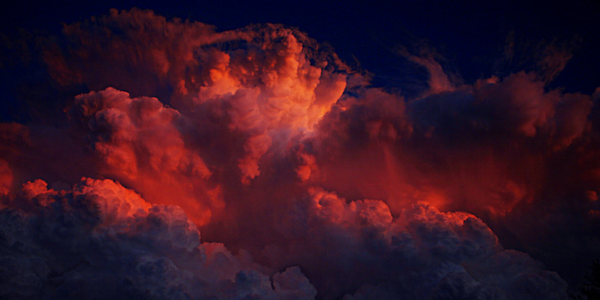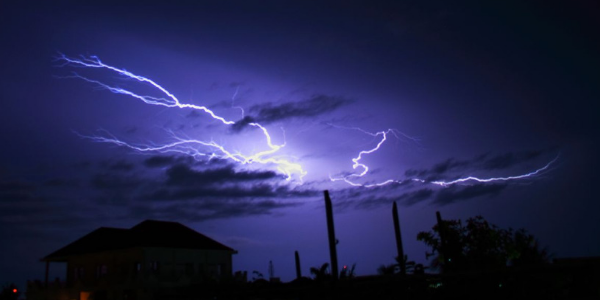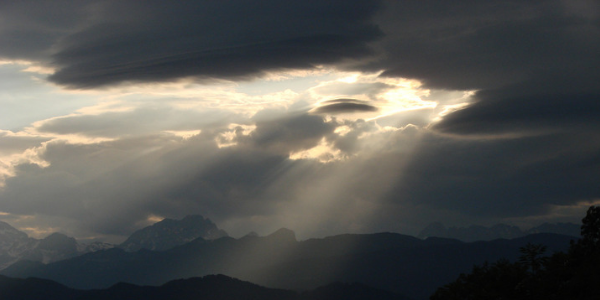
I close my eyes and feel the energy of the earth and sky pulling into my body with each breath. I am one with the world…I am the world. My skin is the ground, my blood the rivers and streams, my breath is the wind that blows through the trees, that tugs playfully at hair. When I exhale, I raise my arms and open my eyes…the wind starts to blow – as hard or gently as I will it…
To feel such power is beyond words. I have been doing this since I was a small child before I knew what magick was, much less what weather magick was.
Weather magick
Weather is a major aspect of nature, and witches are natural beings, attuning their lives to the tides of the moon, melding their patterns to the turning of the year. In Weather Witchery, Katrina Rasbold writes, “Part of claiming our own inherent power includes working with the natural elements of Earth, Air, Fire, and Water. There is very little about weather that is not an elemental experience, sometimes to the extreme!”.1
Weather magick is not about exerting control over the elements, but connecting to the flow of energy and moving with the currents to manifest your will. Those who know the secrets of weather magick have a responsibility as great as their power to protect the land.
Ethics of weather witchery are hotly debated. I believe that we should behave responsibly with our magick. The problem with ethics is that everyone has their own guidelines. My advice is to adhere to your personal ethics, and do what you feel is right.
Weather deities and spirits
When performing a weather ritual, you are often instructed to call upon one or more deities or spirits. Based on my education and experience, I suggest you take time getting to know any entities you might call upon one day to help you with a weather working.
Ancient societies lacked our scientific understanding of weather, so it’s understandable that they attributed various weather events to gods and goddesses. There are weather deities in just about every pantheon. In the Encyclopedia of Spirits by Judika Illes, I found no less than 20 different weather deities, and I only made it to “M”! (Masters of Wind, Sorceress of Storm; their titles are all elegant and regal.) There are far too many to list here. If you are drawn to a particular pantheon, I recommend looking up the weather deities of that culture.
What a weather witch can do
Weather magick exists in all cultures and communities in some form or another. The way it is worked varies depending on the magical path. We will look at weather witchery today, and in a second article I will reveal how shamans, druids, and certain First Nations tribes work weather magick. Weather witching has two aspects: harnessing and releasing energy, by way of spellcasting or ritual, or a working of some form to conjure, reroute, or dispel weather.

Harnessing energy
The simplest, most effective way to harness the energy of weather is by cord magick. Get a piece of cord (string, yarn, silk — anything that isn’t easily broken) the length of your forearm (inner elbow to tip of longest finger).
Get as close to the weather event as is safe, and as you knot the cord, envision the energy being captured in each one. I like to make the knots equidistant down the cord, but I’m a perfectionist.
I cannot tell you enough, when it comes to spells and magick the best way is to do what your gut tells you.2
…Out came the sun and dried up all the rain!
In addition to weather deities, I recommend familiarizing yourself with gods and goddesses of the sun.
Many introduction to witchcraft resources tell you that the sun is a “masculine” energy, but after reading Stephanie Woodfield’s book Drawing Down the Sun, I know that this is not true. There are solar goddesses in many cultures, such as: Celtic, Norse, Japan, Finland, the Americas, and several more. Woodfield’s book not only introduces deities from several cultures, but provides guided meditations, rituals and spellwork for them as well. Needless to say, this is a resource I recommend if you wish to become a weather witch.
Conjuring weather
Weather Witchery has a whole chapter on ways to call weather, the easiest of which is “Imitation Magic.” This is when you call weather by simulating the event you wish to conjure. Visualization and intent are major factors in these workings; if you wish to bring rain, you can pour water through a sieve, or beat a drum to call thunder, and so on.
To bring wind you could use a fan, simulating the cool breeze.3 The other way is by wind whistling. This is like the experience I described at the beginning of the article, but instead of breathing you whistle. You can experiment with length of notes and tones to achieve varied results. If you do not know how to whistle, and do not want to bring the wind by blowing, you can create a whistle from alder wood. The whistle sounds like a gust of wind (YouTube has videos of people creating and using wind whistles).
Rain, rain, go away, come again another day!
This little ditty is actually a charm for good weather! Protection from inclement weather is very important to learn. As a weather witch, people will turn to you to protect your neighbourhood during hurricanes, blizzards, and other dangerous weather events. If you call a storm and it gets out of control, you need to know how to rein it in.
One way to gain protection is to perform a ritual honouring a weather deity, providing them with offerings and kindly asking them to redirect or end the weather. Envision a wind god blowing winds to change the direction of the storm, or see a solar goddess radiating beams of sunlight, causing water in the air to evaporate reducing the blizzard to a light snow, or drying up enough rain it sprinkles instead of storms.

Ritual to diminish storms
I found this ritual in “Weather Witching” by Charlynn Walls (published in Llewellyn’s 2015 Magical Almanac).4 It is designed to diminish storms you have prior knowledge of.
There are a few things you must do to prepare for the ritual. The first is to check weather maps to familiarize yourself with the size, speed, and direction the storm is moving in. You will need protection powder (mix sea salt, dragon’s blood, willow, alder, and laurel with mortar and pestle) and lightning elixir (rain water collected during a thunderstorm).
Walk thrice around the property you intend to protect or the circumference of your circle while sprinkling the protection powder. If you’re working inside, I’d advise against this because dragon’s blood can stain carpets. You could perhaps put some in little dishes and place them at the four corners just outside your circle.
Begin the ritual by casting your circle. You may do this in any manner that is most comfortable for you, then say:
I now stand between the worlds, an instrument of the elements for the purpose of this work. This circle is cast.
Call the quarters and invite a god and goddess to your circle. In “Weather Witching,” Walls calls upon the guardians of the Four Winds: Boreas, Guardian of the North Wind; Euros, Guardian of the East Wind; Zephyrus, Guardian of the South Wind; Notos, Guardian of the West wind. She then calls weather gods of the Greek pantheon — Iris, the goddess of the sea and sky and Zeus, the commander of the energies of the sky.
Sit comfortably in your circle or sacred space and visualize the encroaching storm; see it clearly as possible. Anoint a tealight with the lightning elixir and mentally zoom in on the storm. See each element — the thunder, lightning, wind, and rain. Feel the intensity as it draws near, and as the candle burns down imagine each aspect losing momentum and strength. See the storm made up of sections, and each section or wedge of the storm that you imagine breaking off will reduce the intensity.
If you have difficulty with visualizing, print out a weather map showing the approaching storm and bring it and a pair of scissors to the altar with you when you set it up for the ritual. When the candle burns down, cut pieces of the storm off section by section. While you are visualizing, or snipping away, say the following chant:
This storm’s intensity I seek to shake; Calling for the storm to break!
Repeat the chant over and over until the storm has been dispersed. Release the god and goddess, thanking them for their attendance, and express your hope for their blessing upon your work. Release the quarters next, again thanking them for their time and extend your wishes that they fare well.
Open the circle and pat yourself on the back for protecting your land and neighbours from danger.
Wrapping up weather witchery
Becoming a weather witch requires a strong connection to the elements, the weight of the responsibility to protect the land around you, and the strength to defend your practice against naysayers. If you think about it, these are all things that come along with being a witch in general.
I’m not a weather witch, but I am gifted at whistling up (or blowing out, since I can’t whistle) the wind. It is a very empowering experience, knowing I have forged a relationship with the element of air that is so strong it cooperates in moving when I call.
Take care in your actions and think carefully before you act — but other than that, happy weather witching!
Image credits: OU Choctaw, Sophal Chek, ashokboghani
- Katrina Rasbold, Weather Witchery (Rasbold Ink, 2014), 48. [↩]
- Ibid. [↩]
- Ibid. [↩]
- Charlynn Walls, “Weather Witching,” Llewellyn’s 2015 Magical Almanac (Llewellyn Worldwide, 2015). [↩]







